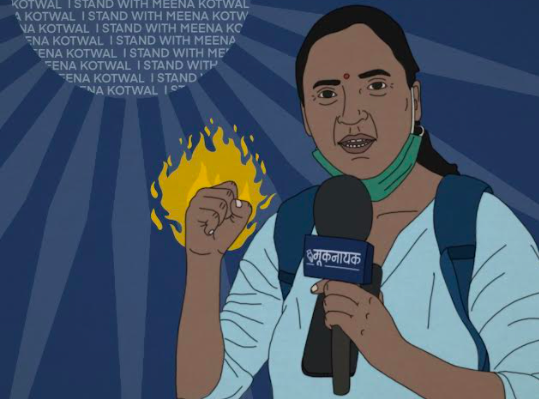Kotwal said that an abuser warned Kotwal that her phone number was being widely distributed on WhatsApp groups and social media pages, with instructions for others to collectively threaten her. She said that she receives caste-based and gender-based hate remarks online as a result of her work exposing atrocities against marginalised populations and casteism in Indian culture.
Suchitra | TwoCircles.net
NEW DELHI — A Dalit woman journalist Meena Kotwal is facing online abuse and threats after she posted a video of herself burning the Manusmriti on December 25. Manusmriti is an ancient legal text or ‘dharmashastra’ of Hinduism and is revered by some sections of Hindu society, while others believe the text “demeans women.”
क्या मेरी तरह आज आपने मनुस्मृति जलाया? इसका मजा ही कुछ और है…
ऐसे ही आज इस घटिया किताब को जलाएं और फोटो वीडियो शेयर करें। हम अब ऐसा लगातार करते रहेंगे, सिर्फ जलाएंगे ही नहीं बल्कि इसके विचारों को नेस्तनाबूद कर देंगे। बाबा साहेब ने भी यही किया था?
आग ऐसी लगाई मजा आ गया ??? pic.twitter.com/JEkd2I7sTm
— Meena Kotwal (मीना कोटवाल) (@KotwalMeena) December 25, 2021
Kotwal, who is the founder of The Mooknayak, had posted the video on the occasion of “Manusmriti Dahan Divas” (Manusmriti Burning Day) to commemorate Dr Bhimrao Ambedkar’s metaphorical burning of the ancient law document that sustains the Hindu caste system in 1927.
Talking to TwoCircles.net, she said she soon began to receive violent threats by men claiming to be associated with Hindutva nationalistic groups like Bajrang Dal, Karni Sena, Vishwa Hindu Parishad.
“You will suffer the same fate as Gauri Lankesh,” multiple callers told Kotwal.
In one of the conversations, the abuser warned Kotwal that her phone number was being widely distributed on WhatsApp groups and social media pages, with instructions for others to collectively threaten her, Kotwal recounted to TwoCircles.net.
The men demanded that she should remove the video which she had shared. When she refused, they threatened her with physical violence.
The Mooknayak is a media platform that reports primarily on disadvantaged populations. Meena has been unable to work for the last seven days due to fear. She is afraid to pick up calls and step out of her house. “They have Manu in their minds, and that is why they attack the agency of women and want to lock them up inside their houses. They fear that Dalits like myself, especially Dalit women, will begin to understand their oppression and fight against them,” Meena said.
Even though Meena submitted a complaint three days ago, no FIR has been filed on the threats she is facing. This is not the first time there hasn’t been any action against a case filed by her.
“In most circumstances, getting the police to submit a complaint under the Prevention of Atrocities Act is extremely impossible. I have a first-hand experience with this,” Kotwal remarked.
Three months ago, she had filed a complaint against a Twitter user for caste-based hate remarks. “It was difficult to have the FIR lodged under the statute without public pressure and indignation on social media.”
In 1955, India enacted the Protection of Civil Rights (Anti-Untouchability) Act, and in 1989, the Scheduled Caste/Scheduled Tribe Prevention of Atrocities Act, which criminalises casteist slurs and abuse against SC/ST individuals or groups. However, the act has the most abysmal rates of conviction in the country at less than 8%.
“Dalit women journalists, particularly those who are outspoken, are rarely seen. They have resorted to intimidatory measures because they do not want the status quo to alter,” Kotwal said.
Kotwal has documented the brutalization of Dalit, Bahujan, and Adivasi people, particularly women. She was the first journalist to cover the gang rape of a nine-year-old Dalit girl in Delhi.
As a journalist who reports frequently from a variety of on-the-ground places, Kotwal believes these threats are specifically made “to frighten and intimidate her into not working.”
“I want it to be known that if anything happens to me or my family, Bajrang Dal and other Hindutva organisations are to blame,” she said.
Kotwal said that she has received multiple caste-based and gender-based hate remarks online as a result of her work exposing atrocities against marginalised populations and casteism in Indian culture.
Poor media freedom in India
According to various international studies, India remains a dangerous place for journalists. India ranked 142 out of 180 nations on the Press Freedom Index in April 2021. According to the research, the ruling Bharatiya Janata Party (BJP) and extremist right-wing Hindutva ideologues have created a hazardous atmosphere for journalists who dare to discuss or write on topics that ‘trouble Hindutva devotees.’ According to Reporters Without Borders assessment, India is one of the “most hazardous nations for journalists.”
“If it had been a Savarna woman journalist, they would have taken to the streets,” Kotwal said.
Kotwal is dissatisfied with the lack of support for her, particularly from those who have been loud about hate crimes in India.
“The fact that I am a Dalit woman makes it even more difficult for me,” Kotwal remarks.
The International Dalit Solidarity Network, a non-governmental organisation that aims to end caste-based discrimination on a worldwide scale, recorded caste-based hate speech on social media platforms in their research. According to the survey, Dalit users have experienced psychological discomfort as a result of persistent casteist harassment and insufficient safety measures implemented by social media platforms that hold abusers accountable. According to the survey, as a result of this, many Dalit women have chosen to conceal their identity.
“These series of threats must be seen as what it is; a deliberate attempt to silence the voice of a Dalit woman,” Kotwal asserted.
Suchitra is an independent journalist working on social justice, focusing primarily on gender justice. She tweets at @Suchitrawrites


